F56 Drivetrain Malfunction + Misfires
#26
That said, high voltage on S2 indicates running rich, which correlates with your S1 lambda value being greater than 1 and your 99% STFT readings in that one pic. Your 2.3% LTFT reading in the other you added also points towards running rich.
Given all this correlation I’m not sure the O2 sensors are wrong (though that S1 voltage and the condition it was taken under — idle, not idle, whatever — would provide a way to cross-check against reference values).
LTFT and STFT are adjustments made by an ECU. The implication is that the DME is making the fuel mixture rich, and the O2 sensor values are basically saying “yeah, running rich.” Why the DME would do that, though, and not back off based on that feedback from the O2 sensors, is not clear to me at all.
#29
Need voltage (V), not current (mA).
That said, high voltage on S2 indicates running rich, which correlates with your S1 lambda value being greater than 1 and your 99% STFT readings in that one pic. Your 2.3% LTFT reading in the other you added also points towards running rich.
Given all this correlation I’m not sure the O2 sensors are wrong (though that S1 voltage and the condition it was taken under — idle, not idle, whatever — would provide a way to cross-check against reference values).
LTFT and STFT are adjustments made by an ECU. The implication is that the DME is making the fuel mixture rich, and the O2 sensor values are basically saying “yeah, running rich.” Why the DME would do that, though, and not back off based on that feedback from the O2 sensors, is not clear to me at all.
That said, high voltage on S2 indicates running rich, which correlates with your S1 lambda value being greater than 1 and your 99% STFT readings in that one pic. Your 2.3% LTFT reading in the other you added also points towards running rich.
Given all this correlation I’m not sure the O2 sensors are wrong (though that S1 voltage and the condition it was taken under — idle, not idle, whatever — would provide a way to cross-check against reference values).
LTFT and STFT are adjustments made by an ECU. The implication is that the DME is making the fuel mixture rich, and the O2 sensor values are basically saying “yeah, running rich.” Why the DME would do that, though, and not back off based on that feedback from the O2 sensors, is not clear to me at all.
#30
Ok. Suggestion for you in the future: pick up the paid version of BimmerLink and a vGate iCar Bluetooth 4.0 (BLE) OBD-II adapter (or equivalent of the vGate, but the vGate is cheap and not MINI-specific so it will hold its value). BimmerLink will allow you to get BMW/MINI-specific codes from the individual modules, and not just permanent codes.
I have a wild guess over here about what is going on with your MINI, but I don't know for a fact how the DME will respond to an S2 O2 voltage that is "out of high range" (beyond whatever threshold), so it's just a wild guess.
I have a wild guess over here about what is going on with your MINI, but I don't know for a fact how the DME will respond to an S2 O2 voltage that is "out of high range" (beyond whatever threshold), so it's just a wild guess.
#31
The discussion I see in forums is that if the post-cat O2 sensor value is being substituted, the substitute value is/may be "open loop" (vs. closed loop -- what you get after warmed up but not during WOT or heavy load) -- and the net takeaway is that open loop = "throw more gas at the engine." That would equate to a rich condition, which you seem to have signs of all over the place.
I do see authoritative documentation about the DME using a substitute value if there is "a fault" with the post-cat O2 sensor. But it doesn't define fault, and doesn't say what the substitute value is. So this remains conjecture, but conjecture backed up by some folks' discussions out there in forumland.
If this were my car, my diag focus would be on the post-cat O2 sensor. The DME is supposed to compensate for sensor issues to keep the car safe and operational, with or without a check engine light, and not necessarily in ways that will make sense to the driver. So this doesn't sound to me like a broken DME so much as a DME doing its job.
If you get your hands on BimmerLink I would not be surprised if it found the car explicitly throwing a complaint that the oxygen sensor 2 value is implausible. Just a hunch.
#32
Ok. Suggestion for you in the future: pick up the paid version of BimmerLink and a vGate iCar Bluetooth 4.0 (BLE) OBD-II adapter (or equivalent of the vGate, but the vGate is cheap and not MINI-specific so it will hold its value). BimmerLink will allow you to get BMW/MINI-specific codes from the individual modules, and not just permanent codes.
I have a wild guess over here about what is going on with your MINI, but I don't know for a fact how the DME will respond to an S2 O2 voltage that is "out of high range" (beyond whatever threshold), so it's just a wild guess.
I have a wild guess over here about what is going on with your MINI, but I don't know for a fact how the DME will respond to an S2 O2 voltage that is "out of high range" (beyond whatever threshold), so it's just a wild guess.
#33
So my wild guess -- which has some anecdotal discussion out there in forums, BMW and otherwise -- is that the voltage on your secondary O2 sensor is implausible (1.25V, top of acceptable range is 1.0V), and since it's implausible, the DME is using a substitute value.
The discussion I see in forums is that if the post-cat O2 sensor value is being substituted, the substitute value is/may be "open loop" (vs. closed loop -- what you get after warmed up but not during WOT or heavy load) -- and the net takeaway is that open loop = "throw more gas at the engine." That would equate to a rich condition, which you seem to have signs of all over the place.
I do see authoritative documentation about the DME using a substitute value if there is "a fault" with the post-cat O2 sensor. But it doesn't define fault, and doesn't say what the substitute value is. So this remains conjecture, but conjecture backed up by some folks' discussions out there in forumland.
If this were my car, my diag focus would be on the post-cat O2 sensor. The DME is supposed to compensate for sensor issues to keep the car safe and operational, with or without a check engine light, and not necessarily in ways that will make sense to the driver. So this doesn't sound to me like a broken DME so much as a DME doing its job.
If you get your hands on BimmerLink I would not be surprised if it found the car explicitly throwing a complaint that the oxygen sensor 2 value is implausible. Just a hunch.
The discussion I see in forums is that if the post-cat O2 sensor value is being substituted, the substitute value is/may be "open loop" (vs. closed loop -- what you get after warmed up but not during WOT or heavy load) -- and the net takeaway is that open loop = "throw more gas at the engine." That would equate to a rich condition, which you seem to have signs of all over the place.
I do see authoritative documentation about the DME using a substitute value if there is "a fault" with the post-cat O2 sensor. But it doesn't define fault, and doesn't say what the substitute value is. So this remains conjecture, but conjecture backed up by some folks' discussions out there in forumland.
If this were my car, my diag focus would be on the post-cat O2 sensor. The DME is supposed to compensate for sensor issues to keep the car safe and operational, with or without a check engine light, and not necessarily in ways that will make sense to the driver. So this doesn't sound to me like a broken DME so much as a DME doing its job.
If you get your hands on BimmerLink I would not be surprised if it found the car explicitly throwing a complaint that the oxygen sensor 2 value is implausible. Just a hunch.
#34
thanks for all your help I really appreciate it , I will forsure look into getting one of those too look into in module cause yes it just pulls stored/permanent codes. I know if the volts are low it’s gonna be sending too much fuel and too high it will send too much air
Glad to help and definitely keep us posted.
The following users liked this post:
evansf56 (07-22-2023)
#35
Could be wiring but there are a lot of things that can make an O2 sensor fail, and no O2 sensor is perfect to begin with. I would inspect the wiring and connector but unless something jumps out during that inspection, I’d presume the sensor is screwed up and replace it.
#36
I wouldn’t be so sure (unless you have a specific source) about high volts = send too much air. I have found at least one BMW discussion where it bottom lines at “if post-car O2 sensor untrustworthy, use open-loop condition.” Given that BMW tends to be consistent in its implementations, that would imply the MINI would do the same, and if that is the case, there is no scenario where open loop = more air. Open loop is always going to send more fuel than closed loop, and that’s a rich condition.
Glad to help and definitely keep us posted.
Glad to help and definitely keep us posted.
The following users liked this post:
cjv2 (07-22-2023)
#37
I will definitely keep you guys posted, going to take another look at them and see if I can get my hands on a bimmerlink soon so I can check out the different modules. Thanks again you’ve been extremely helpful and I know maybe 1 or 2 people out here with f56 who dig in the work themselves
"If the oxygen sensor after catalytic converter is not operational, there may be measured values greater than 1 V due to heating of the monitoring oxygen sensor."
I'd say this points pretty squarely at your post-cat O2 sensor being at issue, since it's throwing a value of 1.25 V.
The following users liked this post:
evansf56 (07-22-2023)
#38
Found something else. I was so busy searching for normal voltage range that I missed reading this -- literally printed right below the detail I posted the screen shot of. D'oh.
"If the oxygen sensor after catalytic converter is not operational, there may be measured values greater than 1 V due to heating of the monitoring oxygen sensor."
I'd say this points pretty squarely at your post-cat O2 sensor being at issue, since it's throwing a value of 1.25 V.
"If the oxygen sensor after catalytic converter is not operational, there may be measured values greater than 1 V due to heating of the monitoring oxygen sensor."
I'd say this points pretty squarely at your post-cat O2 sensor being at issue, since it's throwing a value of 1.25 V.
#39
#40
Max V out of O2 sensor #2 should be 1.0V according to TIS (see one of my posts above with a screen shot). The same area that discloses this says the following point-blank: "If the oxygen sensor after catalytic converter is not operational, there may be measured values greater than 1 V due to heating of the monitoring oxygen sensor." There are also assorted references around the web to the DME ignoring an O2 sensor it thinks is toast, and using some other substitute value/reading instead to decide how to fuel-manage and so on.
Net, a bad O2 sensor #2 can lead to a few things, and yours looks bad, so I would swap that baby out. @evansf56 did so for his O2 #2 and his V dropped from 1.25V (out of spec) down to 0.8V (in-spec).
Separately, do you have a lambda reading from your O2 #1? Should be at 1 or really-really-really close to 1.
#41
Hey @bluedoggy1 , wondering how your progress is coming. I know this thread got a series of fast and furious updates, but the upshot is that separately from the question about your sensor 1 value, your sensor 2 value is out of spec -- which I didn't catch when reading the thread earlier.
Max V out of O2 sensor #2 should be 1.0V according to TIS (see one of my posts above with a screen shot). The same area that discloses this says the following point-blank: "If the oxygen sensor after catalytic converter is not operational, there may be measured values greater than 1 V due to heating of the monitoring oxygen sensor." There are also assorted references around the web to the DME ignoring an O2 sensor it thinks is toast, and using some other substitute value/reading instead to decide how to fuel-manage and so on.
Net, a bad O2 sensor #2 can lead to a few things, and yours looks bad, so I would swap that baby out. @evansf56 did so for his O2 #2 and his V dropped from 1.25V (out of spec) down to 0.8V (in-spec).
Separately, do you have a lambda reading from your O2 #1? Should be at 1 or really-really-really close to 1.
Max V out of O2 sensor #2 should be 1.0V according to TIS (see one of my posts above with a screen shot). The same area that discloses this says the following point-blank: "If the oxygen sensor after catalytic converter is not operational, there may be measured values greater than 1 V due to heating of the monitoring oxygen sensor." There are also assorted references around the web to the DME ignoring an O2 sensor it thinks is toast, and using some other substitute value/reading instead to decide how to fuel-manage and so on.
Net, a bad O2 sensor #2 can lead to a few things, and yours looks bad, so I would swap that baby out. @evansf56 did so for his O2 #2 and his V dropped from 1.25V (out of spec) down to 0.8V (in-spec).
Separately, do you have a lambda reading from your O2 #1? Should be at 1 or really-really-really close to 1.
Edit: I thought it was Bank 1 at fault but took to dealer as it is sulev and after a few days they had to reprogram car and they referenced some i-level issue if I recall correctly. Issue came and went a week later and now again today.
Last edited by bluedoggy1; 08-29-2023 at 10:33 AM.
#42
Issue had come and gone within a day but just came up again today and restarting car made it run 'normally' but wow there are a lot of replies lol. I thought the 0V was the issue. What is the range of acceptable V on B1 O2 sensor? I'll have to try and get the dealer to replace 02 sensor then if the 1.25V is out of spec.
Edit: I thought it was Bank 1 at fault but took to dealer as it is sulev and after a few days they had to reprogram car and they referenced some i-level issue if I recall correctly. Issue came and went a week later and now again today.
Edit: I thought it was Bank 1 at fault but took to dealer as it is sulev and after a few days they had to reprogram car and they referenced some i-level issue if I recall correctly. Issue came and went a week later and now again today.
Let me see what I can dig up about acceptable voltage values for the pre-cat O2 sensor.
More to come...
#43
1.25V is definitely out of spec on the post-cat O2 sensor, and more importantly, when it is over 1.0V the DME, according to TIS, will decide the O2 sensor is not trustworthy and will use some not-stated other value on its own for its decision-making. You can assume that whatever that value is, it's designed to keep the engine spinning at all costs rather than optimized for fuel economy/etc. So I would replace that O2 sensor outright. Doing so helped evansf56 for sure.
Let me see what I can dig up about acceptable voltage values for the pre-cat O2 sensor.
More to come...
Let me see what I can dig up about acceptable voltage values for the pre-cat O2 sensor.
More to come...
I don't understand how the dealer would not notice this though. Ugh.
Last edited by bluedoggy1; 08-29-2023 at 12:23 PM.
#44
The effect would obviously be across all cylinders -- but subject to whatever else was going on in each individual cylinder, so visual observables (as well as others, like misfire) might vary. The real tells are the voltage, the resultant fuel trim effect, and the then-absolutely-expected-things you get when those fuel trims dump more fuel into the chambers. Not much mystery there.
Hope this clarifies the technical. Will post again when I have some data about the other O2 sensor.
Last edited by cjv2; 08-29-2023 at 01:25 PM.
#45
#46
If you have a scanner, check your long-term and short-term fuel trim values. The rear/second/post-cat O2 sensor issue described will manifest as high values for both. By design (*any* fuel-injected car), high fuel trim is a command to inject more fuel into the chamber -- aka running rich, which of course kills fuel economy (and does other things too).
The effect would obviously be across all cylinders -- but subject to whatever else was going on in each individual cylinder, so visual observables (as well as others, like misfire) might vary. The real tells are the voltage, the resultant fuel trim effect, and the then-absolutely-expected-things you get when those fuel trims dump more fuel into the chambers. Not much mystery there.
Hope this clarifies the technical. Will post again when I have some data about the other O2 sensor.
The effect would obviously be across all cylinders -- but subject to whatever else was going on in each individual cylinder, so visual observables (as well as others, like misfire) might vary. The real tells are the voltage, the resultant fuel trim effect, and the then-absolutely-expected-things you get when those fuel trims dump more fuel into the chambers. Not much mystery there.
Hope this clarifies the technical. Will post again when I have some data about the other O2 sensor.
#47
I would say if the 0V is accurate then... well... just hope it doesn't start reading "E" on the fuel tank while you troubleshoot a no-start too lol
#48
Yesterday when I got home I got this data idling (pictures with dials):
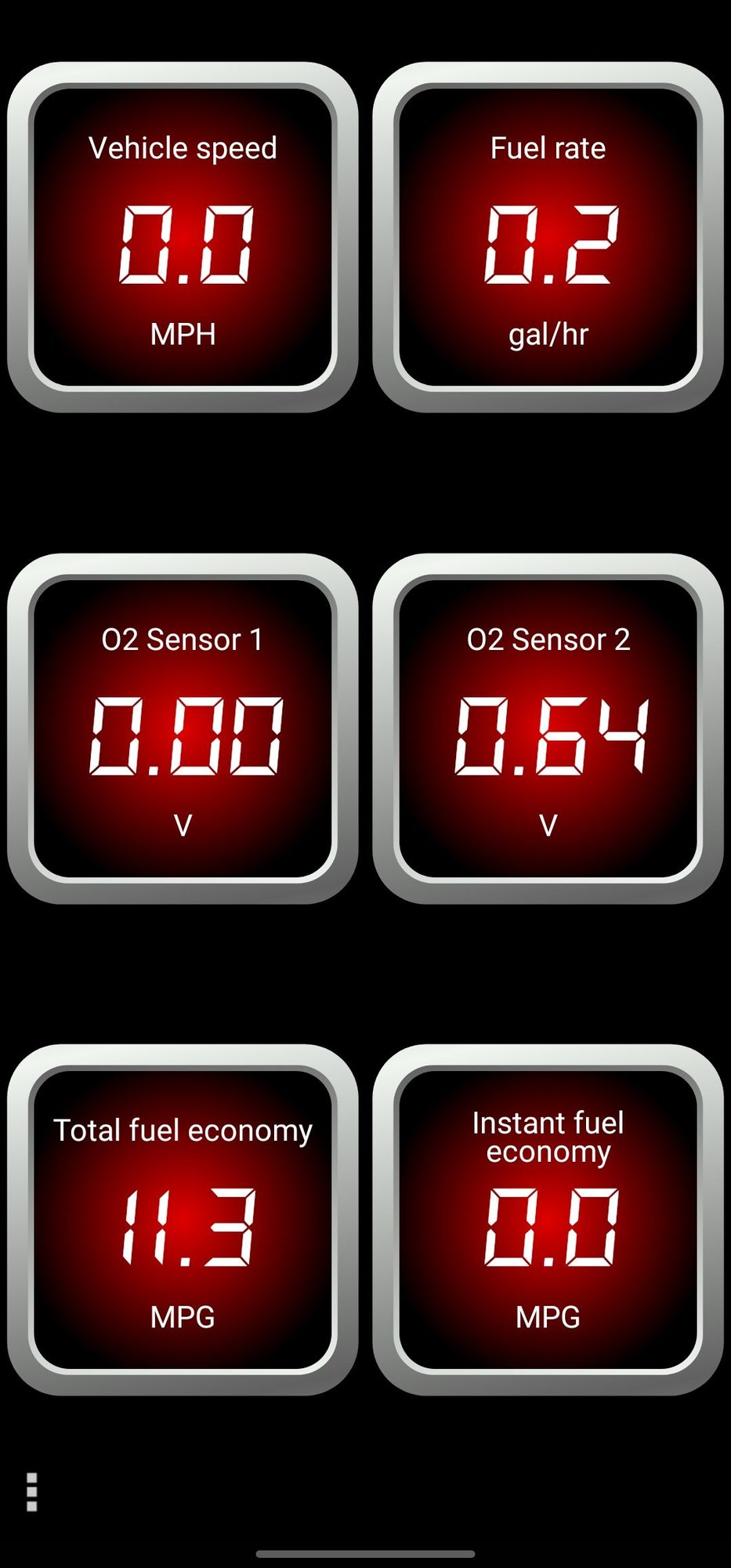
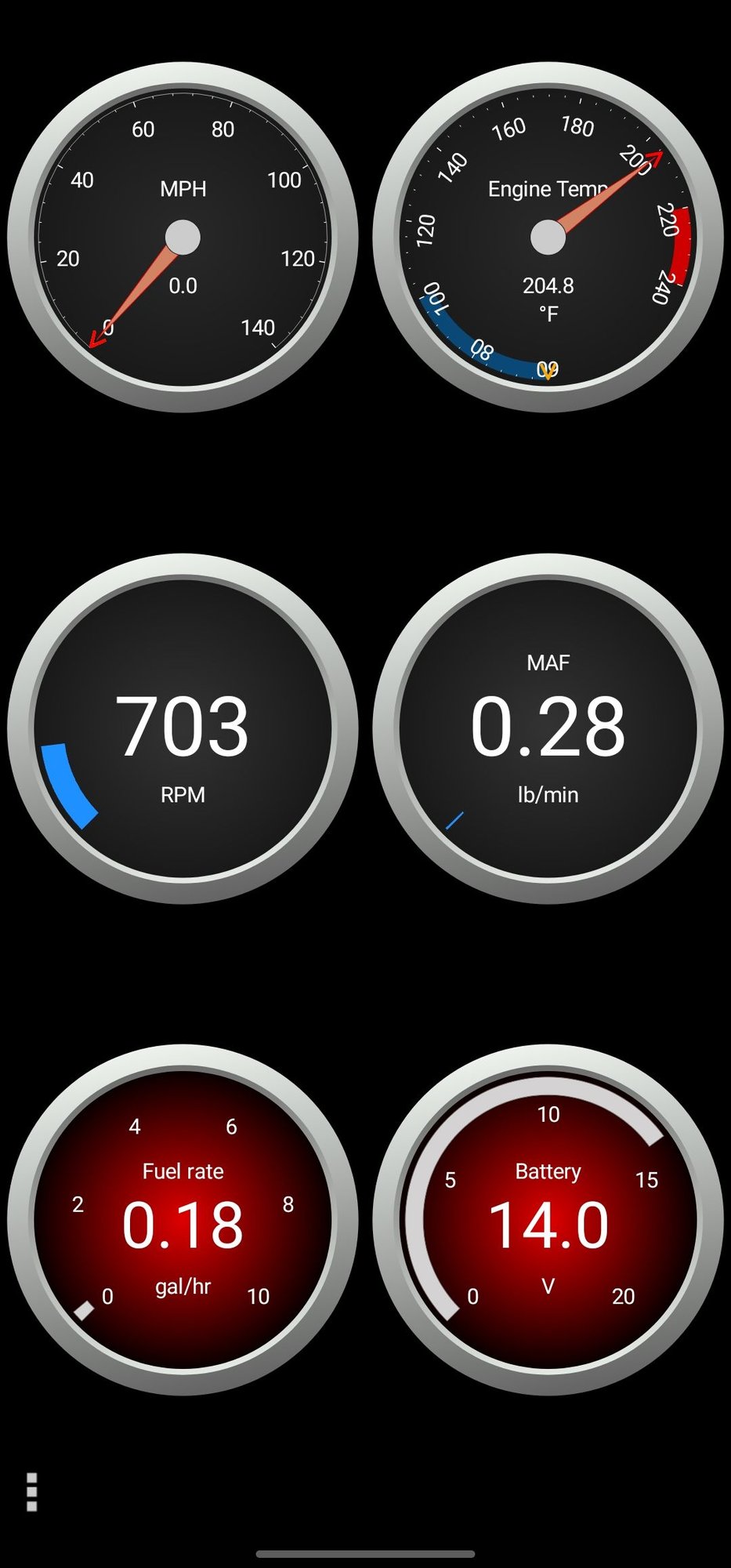
I got following data this morning idle on startup and accelerated engine few times:
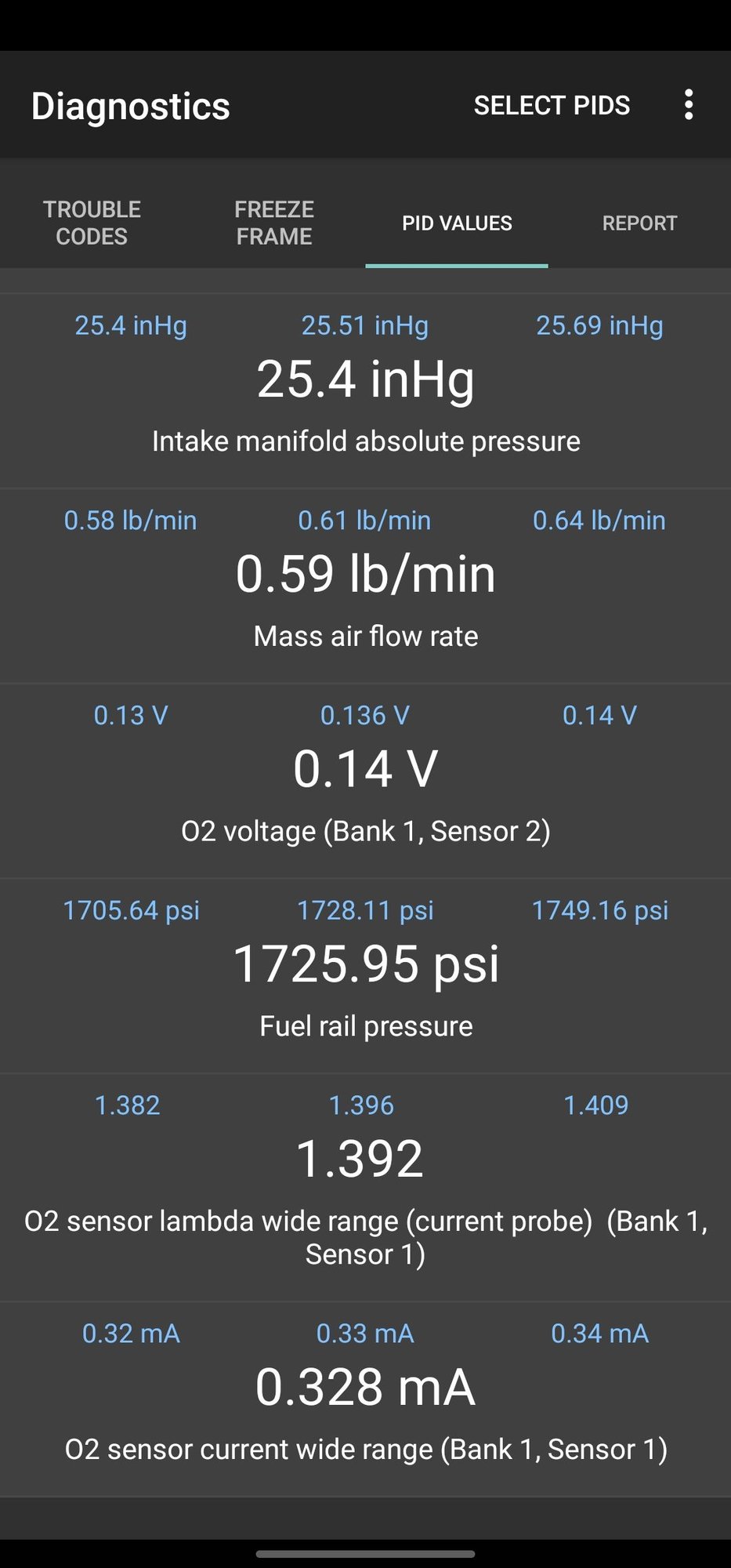

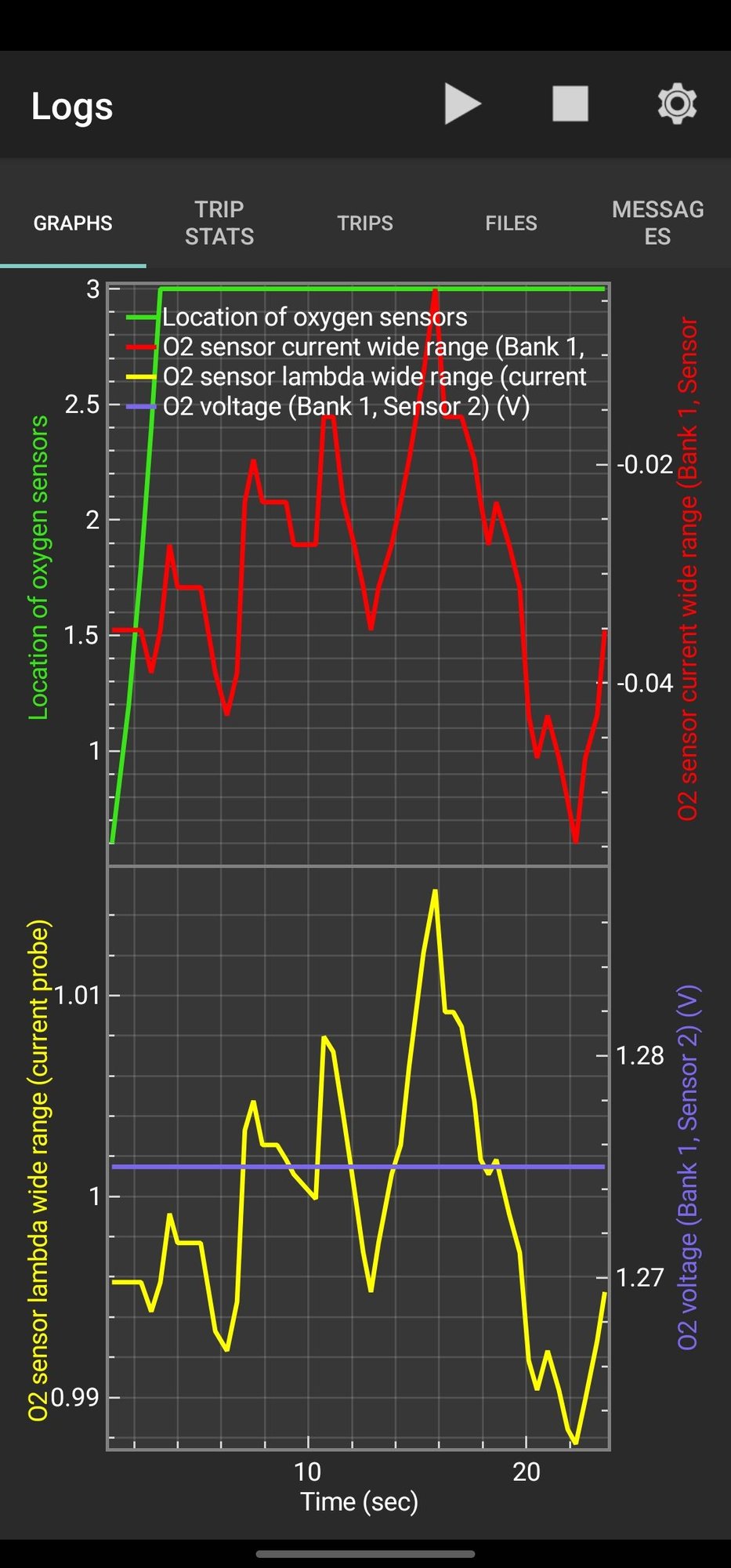
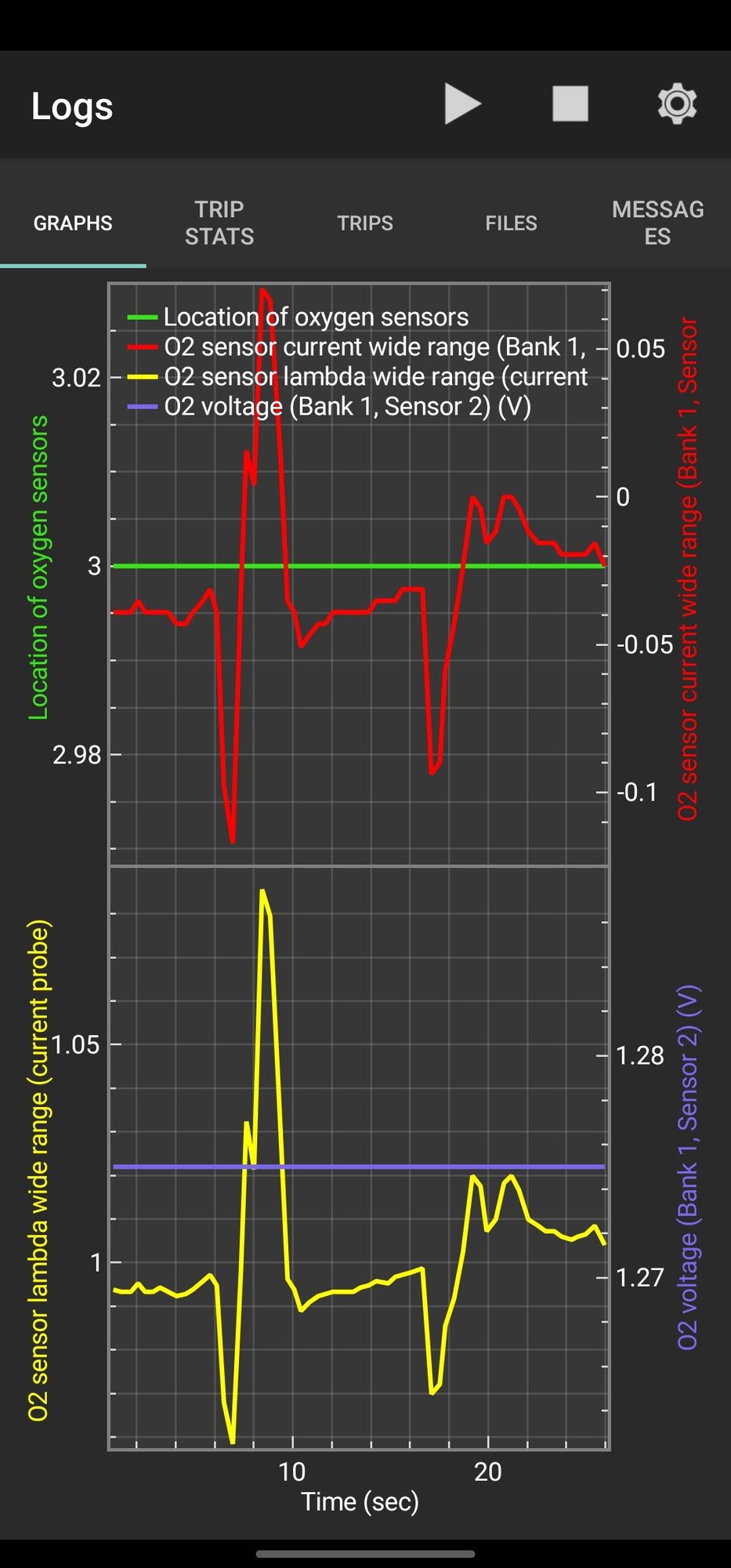
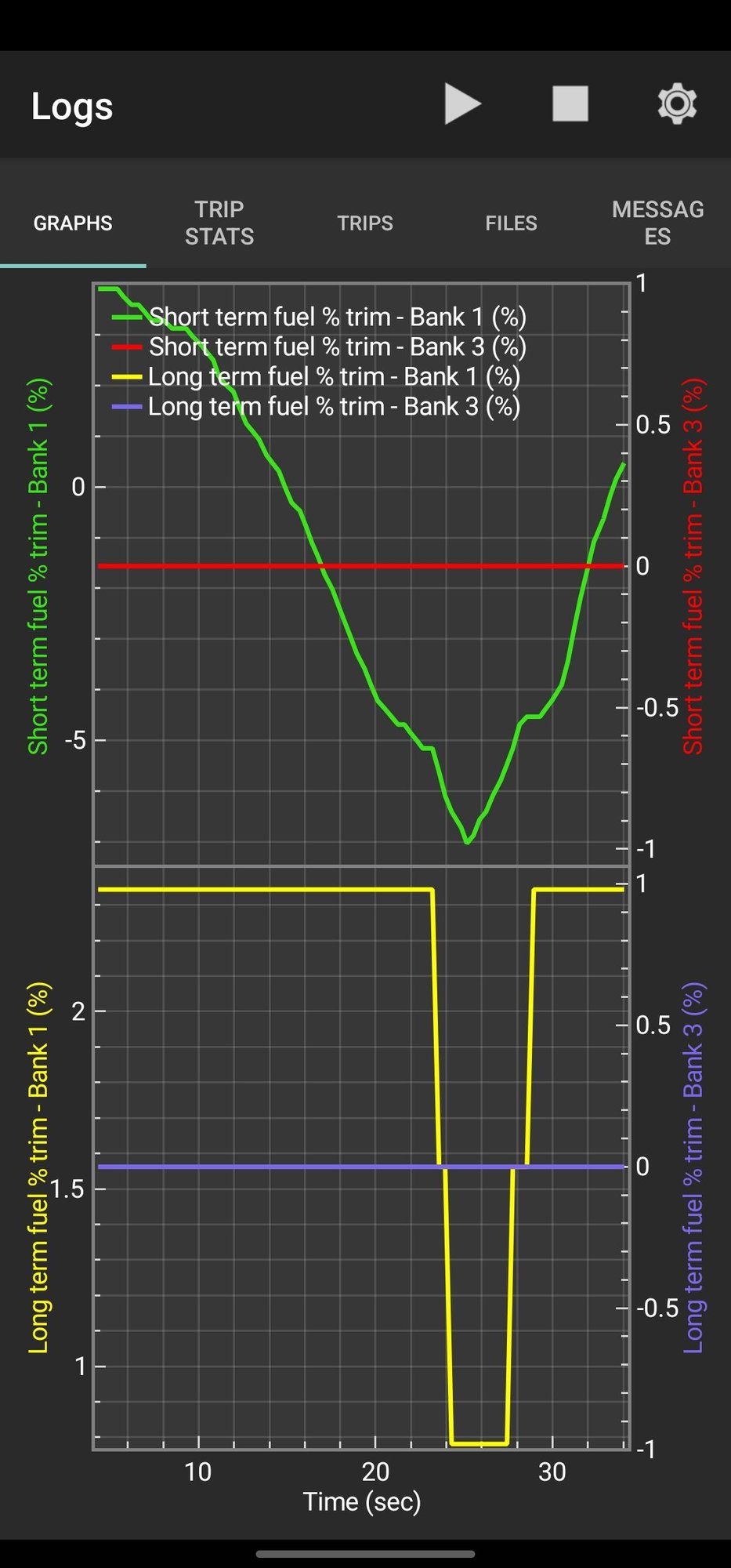
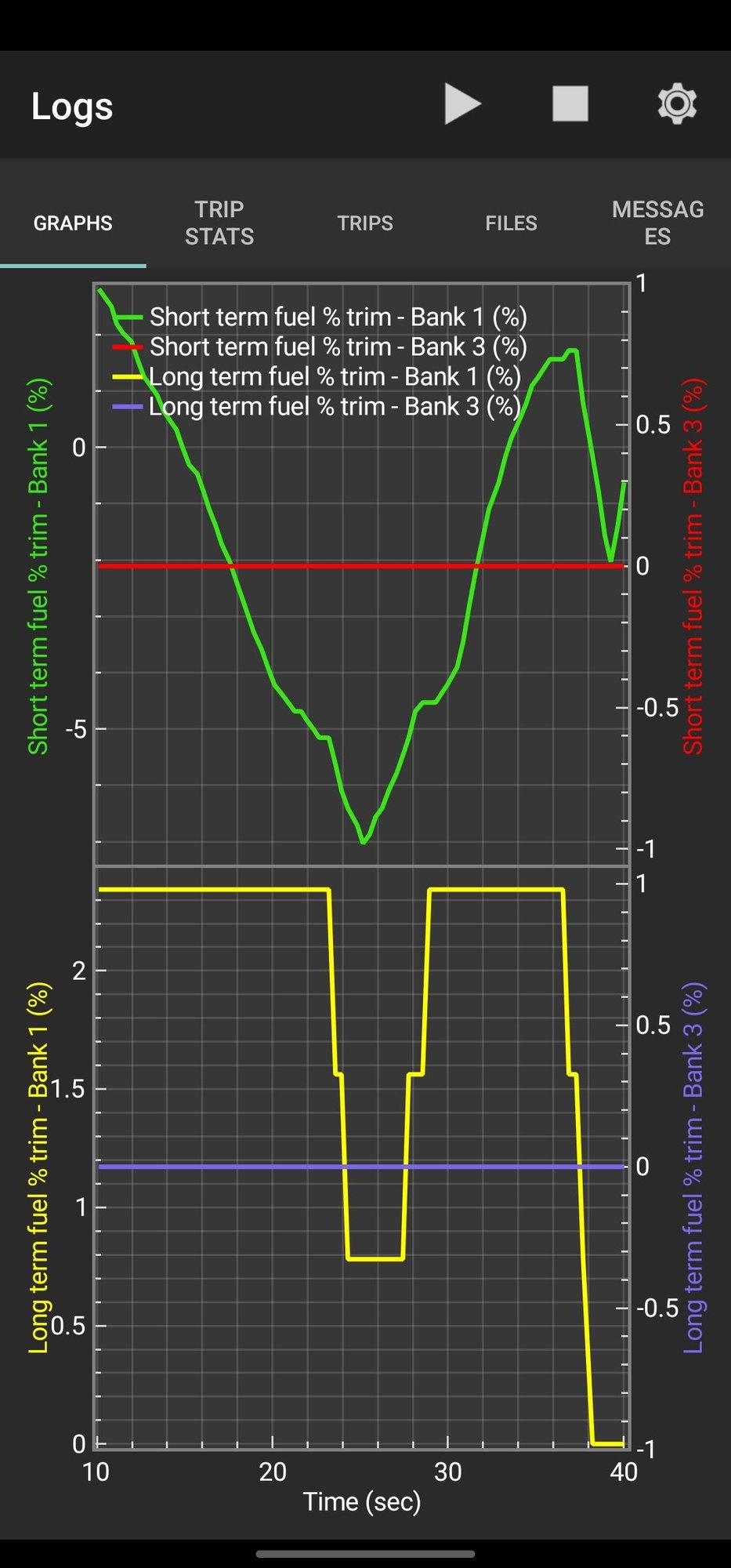
#49
The "lambda sensor" is the first/pre-cat O2 sensor. It is also referred to (generally across all cars) sometimes as the air/fuel sensor. Although the second O2 sensor can (as discussed upthread) screw up air/fuel ratio and cause a vehicle to run rich or lean, the first O2 sensor is the one most commonly discussed as directly controlling how much fuel is injected into the chamber.
I'll come back to that.
Don't worry about BimmerLink. Your OBDLink screen shots look exactly like the OBD Fusion app I have used reliably for years (it doesn't know squat about BMW/MINI-specific trouble codes, but it is good for gathering OBD-level information).
Your short term fuel trim looks great. Settling in at dead zero is fine. If you happen to watch that number while driving you will see it spike and drop based on real-time power demand/lack thereof, which is exactly what it's supposed to do. Landing at zero when you're putting no demand on the vehicle beyond sitting still makes sense.
Your long term fuel trim, at 2.34%, looks high to me. I don't expect this to settle in at zero but on cars that are "healthy" (for lack of a better term) I have seen it park at a negative number between 0 and 1 -- or if on the high side, at a positive number between 0 and 1. A value of 2 or higher, whether negative (lean the mixture out) or positive (richen the mixture) strikes me as indicating something driving that instruction to tweak the mixture is "off." So in your case, not only is your long term fuel trim saying "run richer," it looks like the "level" of enriching is high.
Back to the first O2 sensor, aka the lambda sensor.
Condensed and oversimplified, there is an "ideal air to fuel ratio" of 14.7:1 (14.7 kg air to 1 kg fuel). This ratio is distilled to a "lambda value" of 1. So the theoretical ideal fuel:air lambda is 1. If the amount of air is higher than the 14.7 in this 14.7:1 ratio, lambda measured by the lambda sensor goes up (above 1). This represents a lean condition (more air than ideal in relation to fuel). If the amount of air is lower than the 14.7 in this 14.7:1 ratio, lambda measured by the lambda sensor goes down (below 1).
Bear in mind that unlike fuel trim, which is an instruction to the engine, the lambda value is a sensed value. In other words, the first O2 sensor is, oversimplified, trying to ID the amount of air vs fuel. If it comes in at 1, you're dead-on. If it comes in above 1, the indication is that the air/fuel mixture is lean. If it comes in below 1, the indication is that the air/fuel mixture is rich.
At idle (when you took the screen shots), you have a lambda value of 1.392, which is definitely above 1. Presuming that hanging around this number (or at least above 1) is where your car is on average, that would mean you're running lean on average, which is weird. Notably, if you are running lean on average, that would prompt the DME to richen up the air/fuel mixture -- which would come through as that long term fuel trim saying "hey, put more fuel in there."
In short, though this is a diag from across the Internet and from behind a keyboard, I'd say you have a lean condition that your car is trying to compensate for by adding fuel. But it probably can't add enough to balance things out, given that the lambda value is still high. So over time, you're going to get symptoms associated with a car running rich (even though root cause may be the car trying to compensate against running lean).
Two conclusions from this.
(1) Check for an intake-side air leak. That means literally everywhere from that plastic dual nozzle that clips down right at the front of the hood/engine bay to the air filter, back to the turbo, and then from the turbo to the throttle body, and from the throttle body to the intake manifold and then to the cylinder block. Most common places to look would obviously be places that get tinkered with. You don't unbolt the intake manifold every day so it's not the first suspect. The air filter, its seal, and the seals/closest fittings before and after, however, definitely first suspects. You get the idea.
(2) Your 1.25V on the second O2 sensor may be a flag of something other than the O2 sensor itself having a problem. It is possible to have an exhaust-side air leak. Likely? Not so much, when was the last time something pried a hole somewhere between the exhaust manifold and rear O2 sensor or anywhere else down the exhaust pipe? But it's possible. Can the weird lean condition upstream cause the downstream O2 to throw this out of spec voltage? Not sure -- beyond my expertise. But I would definitely want to sort that lean condition first, given that it is clearly documented in the numbers and that your car is doing exactly what it is supposed to if it senses a lean condition -- trying to sort it by consuming more fuel.
Finally, all this whatnot going on, if happening to my MINI, would absolutely lead me to expect eventual possibilities like rough running and/or misfires and predictable consequences of same -- slowly, not all at once or in some kind of super-spike of obviousness. Net, an engine has to "be in tune" to produce "in tune" results. If it is "out of tune" it will develop "out of tune weirdnesses" accordingly.
Hope this is useful information. I'd start checking the intake, stem to stern, by hand.
I'll come back to that.
Don't worry about BimmerLink. Your OBDLink screen shots look exactly like the OBD Fusion app I have used reliably for years (it doesn't know squat about BMW/MINI-specific trouble codes, but it is good for gathering OBD-level information).
Your short term fuel trim looks great. Settling in at dead zero is fine. If you happen to watch that number while driving you will see it spike and drop based on real-time power demand/lack thereof, which is exactly what it's supposed to do. Landing at zero when you're putting no demand on the vehicle beyond sitting still makes sense.
Your long term fuel trim, at 2.34%, looks high to me. I don't expect this to settle in at zero but on cars that are "healthy" (for lack of a better term) I have seen it park at a negative number between 0 and 1 -- or if on the high side, at a positive number between 0 and 1. A value of 2 or higher, whether negative (lean the mixture out) or positive (richen the mixture) strikes me as indicating something driving that instruction to tweak the mixture is "off." So in your case, not only is your long term fuel trim saying "run richer," it looks like the "level" of enriching is high.
Back to the first O2 sensor, aka the lambda sensor.
Condensed and oversimplified, there is an "ideal air to fuel ratio" of 14.7:1 (14.7 kg air to 1 kg fuel). This ratio is distilled to a "lambda value" of 1. So the theoretical ideal fuel:air lambda is 1. If the amount of air is higher than the 14.7 in this 14.7:1 ratio, lambda measured by the lambda sensor goes up (above 1). This represents a lean condition (more air than ideal in relation to fuel). If the amount of air is lower than the 14.7 in this 14.7:1 ratio, lambda measured by the lambda sensor goes down (below 1).
Bear in mind that unlike fuel trim, which is an instruction to the engine, the lambda value is a sensed value. In other words, the first O2 sensor is, oversimplified, trying to ID the amount of air vs fuel. If it comes in at 1, you're dead-on. If it comes in above 1, the indication is that the air/fuel mixture is lean. If it comes in below 1, the indication is that the air/fuel mixture is rich.
At idle (when you took the screen shots), you have a lambda value of 1.392, which is definitely above 1. Presuming that hanging around this number (or at least above 1) is where your car is on average, that would mean you're running lean on average, which is weird. Notably, if you are running lean on average, that would prompt the DME to richen up the air/fuel mixture -- which would come through as that long term fuel trim saying "hey, put more fuel in there."
In short, though this is a diag from across the Internet and from behind a keyboard, I'd say you have a lean condition that your car is trying to compensate for by adding fuel. But it probably can't add enough to balance things out, given that the lambda value is still high. So over time, you're going to get symptoms associated with a car running rich (even though root cause may be the car trying to compensate against running lean).
Two conclusions from this.
(1) Check for an intake-side air leak. That means literally everywhere from that plastic dual nozzle that clips down right at the front of the hood/engine bay to the air filter, back to the turbo, and then from the turbo to the throttle body, and from the throttle body to the intake manifold and then to the cylinder block. Most common places to look would obviously be places that get tinkered with. You don't unbolt the intake manifold every day so it's not the first suspect. The air filter, its seal, and the seals/closest fittings before and after, however, definitely first suspects. You get the idea.
(2) Your 1.25V on the second O2 sensor may be a flag of something other than the O2 sensor itself having a problem. It is possible to have an exhaust-side air leak. Likely? Not so much, when was the last time something pried a hole somewhere between the exhaust manifold and rear O2 sensor or anywhere else down the exhaust pipe? But it's possible. Can the weird lean condition upstream cause the downstream O2 to throw this out of spec voltage? Not sure -- beyond my expertise. But I would definitely want to sort that lean condition first, given that it is clearly documented in the numbers and that your car is doing exactly what it is supposed to if it senses a lean condition -- trying to sort it by consuming more fuel.
Finally, all this whatnot going on, if happening to my MINI, would absolutely lead me to expect eventual possibilities like rough running and/or misfires and predictable consequences of same -- slowly, not all at once or in some kind of super-spike of obviousness. Net, an engine has to "be in tune" to produce "in tune" results. If it is "out of tune" it will develop "out of tune weirdnesses" accordingly.
Hope this is useful information. I'd start checking the intake, stem to stern, by hand.
The following users liked this post:
cargusjoh (11-20-2023)
#50
@bluedoggy1 did you ever get this sorted? Just ran into something here that may or may not cause your issue, but easy enough to check.



